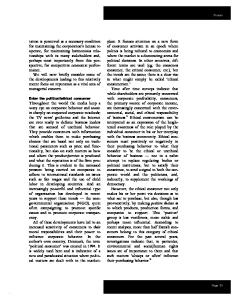Corporate Identity and Corporate Associations: A Framework for Future Research
- PDF / 251,594 Bytes
- 10 Pages / 594.976 x 764.976 pts Page_size
- 38 Downloads / 346 Views
Volume 5 Numbers 2 and 3
Corporate Identity and Corporate Associations: A Framework for Future Research Peter A. Dacin Queen’s University Tom J. Brown Oklahoma State University
ABSTRACT This paper captures the thoughts of an international consortium of researchers who study marketing-related phenomena related to the managerial choices and actions involved in organizational identity formation and communication, and the resulting interpretations and reactions of individual, group and societal constituents. It presents a framework for research and a listing of initial research priorities with the intent of encouraging all readers, regardless of academic discipline, to contribute to this growing field of inquiry that will have important implications for the study and practice of corporate branding.
Corporate Reputation Review, Vol. 5, Nos. 2/3, 2002, pp. 254–263 # Henry Stewart Publications, 1363–3589
Page 254
INTRODUCTION At the heart of corporate branding lie two central concepts, corporate identity and corporate associations. Each of these concepts represents a different perspective on corporate branding phenomena. While the concept of corporate identity has been of long-standing interest to marketing practitioners, only recently has it attracted the sustained attention of marketing academics. (In its broadest sense, the term ‘corporate’ refers to a united group of individuals. In a marketing context, this united group of individuals can be one of several types of organizations including companies, notfor-profit organizations, or any other
group of individuals actively engaged in marketing products, services, ideas, etc.) Corporate identity refers to those intended characteristics of an organization that decision-makers and marketers within the group choose to promote to their internal and external constituents. As many corporate reputation and image theorists have noted, however, this is only half the story. It is often the case that the intended characteristics of a group marketed by decision makers are not the same aspects associated with the group by internal and external constituencies. Thus, the other half of the story includes the interpretations and responses of these other internal and external individual, group and societal constituents. The term corporate associations is used here, to refer to any types of beliefs, moods and emotions, evaluations etc, about an organization that are held by individuals and that are mentally associated with the organization. Corporate associations may (or may not) include individuals’ interpretations of the corporate identity desired by an organization’s managers. In essence, corporate associations represent how individuals think and feel about the organization. For marketers, understanding how to develop and manage corporate identity is
Dacin and Brown
inextricably linked to understanding how and why various constituents form corporate associations and the specific corporate associations that they hold. Just as brand managers need to keep on top of what consumers thin
Data Loading...











